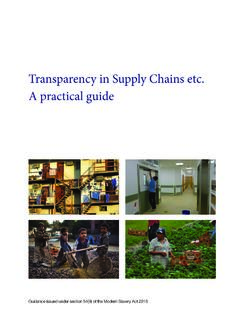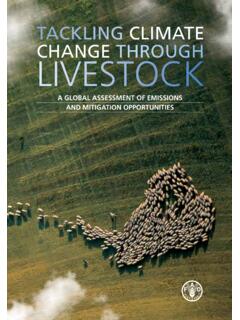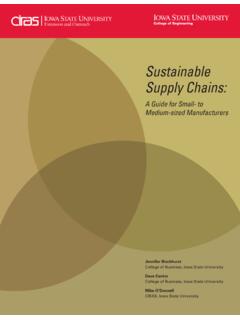Transcription of PPE COVID-19 Supply Chains Bottlenecks Policy
1 Global Shortage of Personal Protective Equipment amid COVID-19 ADB BRIEFSNO. APRIL ISBN - - - - (print)ISBN - - - - (electronic) ISSN - (print)ISSN - (electronic)Publication Stock No. BRF - DOI: . /BRF - Global Shortage of Personal Protective Equipment amid COVID- : Supply Chains , Bottlenecks , and Policy Implications KEY POINTS Since the COVID- outbreak, the Supply chain for personal protective equipment (PPE) has not adequately functioned to meet the surge in demand. Constraints in Supply and logistics, including export bans for PPE and key materials, have come into stark focus. Abrupt Supply disruptions in the People s Republic of China (PRC), the major producer of PPE in the global trade network and the first country to be hit by the coronavirus, are having spillover impacts on Asia and the rest of the world. Trade restrictions and export bans in more than economies also exacerbate the problems in PPE production and distribution.
2 Reorienting manufacturers of nonmedical devices for PPE production is among the extraordinary measures being taken to end Bottlenecks in Supply . But more actions are needed. Multilateral development banks including the Asian Development Bank are well-placed to help increase PPE production and logistics capacity; strengthen Supply chain and trade finance programs; and target aid to support vulnerable groups such as women, children, and the TO GLOBAL Supply OF PERSONAL PROTECTIVE EQUIPMENTThe COVID- pandemic is rapidly spreading across countries and regions, causing huge impact on people s lives and communities. Starting as a health crisis, it now poses serious threats to the global economy, trade, and finance, with the estimated economic impacts to range between trillion and . trillion globally (ADB a). Surging demand, partly joined with panic buying, hoarding, and misuse of personal protective equipment (PPE) amid the COVID- pandemic, is disrupting global supplies and putting lives at risk.
3 Demand has surged, overwhelming global production capacity. The dramatic rise in demand for surgical masks, goggles, gloves, and gowns has depleted stockpiles, prompted significant price increases, and led to production backlogs of months in fulfilling orders. The most significant challenge is to ensure that critical PPE products are sourced and allocated to frontline health workers and other responders in affected countries, especially those most vulnerable to the spread of the coronavirus. The World Health Organization (WHO) estimated that million medical masks are required for the COVID- response each month, along with million examination gloves and . million medical goggles (WHO ). WHO itself has so far shipped nearly half a million sets of personal protective equipment to countries, but supplies are depleting rapidly.
4 To meet rising global demand, WHO estimates that industry must increase manufacturing by and urges governments to act quickly to boost HOW Supply Chains OPERATE IS CRUCIALS upply chain disruptions for PPE are particularly risky for medical personnel as COVID- rapidly spreads. If not adequately protected, healthcare workers who are the frontline defense against coronavirus can infect patients or colleagues, and The authors of this brief are Cyn-Young Park, Kijin Kim, Susann Roth, Steven Beck, Jong Woo Kang, Mara Claire Tayag (Asian Development Bank); and Michael Griffin (World Health Organization). Research support was provided by Joshua Anthony Gapay, Benjamin Endriga, Marife Lou Bacate, Zemma Ardaniel, Ana Kristel Lapid, Concepcion Latoja, and Clemence Fatima BRIEFS NO. the need to be quarantined after exposure quickly depletes the health workforce.
5 Medical Supply Chains are essential elements of a well-functioning health system. To respond to infectious disease outbreaks effectively, health Supply systems should be designed to swiftly and reliably source and deliver essential health commodities, including vaccines, medicines, and PPE for healthcare workers, which are needed during outbreaks, epidemics, and pandemics. The ongoing coronavirus pandemic exposes the vulnerabilities of Supply Chains across many industries. Over the past few years, healthcare systems in many countries have encouraged or forced the offshoring of PPE production to low-cost providers. In the United States (US), of surgical masks and of respirators are produced overseas (Flynn ). Amid the COVID- outbreak in the People s Republic of China (PRC), factory shutdowns and bans on travel and PPE exports have put significant strain on PPE Supply Chains , while the evolving pandemic nature of COVID- leads to political and technical constraints in supplying the market.
6 To improve inventory management efficiency, the just-in-time system has been implemented worldwide for materials critical for PPE products, resulting in an overall reduction in national stocks. Since this contrasts with the idea of pandemic planning and stockpiling, it has caused PPE stocks to be insufficient to meet the surge in demand for PPE during disease outbreaks (ICT ). PPE Market OverviewPPE and pharmaceutical manufacturing in Asia and the Pacific is significant. Prominent producers operate in the PRC, while India meets about of global demand for medicines and vaccines, the Republic of Korea remains among the most significant pharmaceutical manufacturing markets, and Singapore is a regional hub for international pharmaceutical companies (Mordor Intelligence ). PPE is clothing and equipment designed to protect the wearer from injury or spread of infection.
7 Key PPE items including N masks, surgical masks, gowns, and goggles are essential for healthcare workers. Most of the raw materials and inputs used to produce PPE are outsourced to low-cost suppliers. Production of these items often requires imports of raw materials such as cotton fiber, polyester, and polyamide produced by different manufacturers around the world. These are processed by protective clothing manufacturers for sale to end users. The global market for PPE in the health sector was estimated to be worth . billion in . Gloves have the highest share of sales revenues at , followed by suits or coveralls at . Face masks and hats came in third with a share of (Figure ). By region, the US had the largest market share ( ), followed by Asia and the Pacific ( ), and Europe ( ) in (Mordor Intelligence ). Figure . Market Share by PPE Product and Region, (revenue million, )PPE personal protective : Mordor Intelligence ( ).
8 Suits or Coveralls Gloves Aprons Face Masks and Hats ProtectiveEyewear and Cleanroom Googles Footwear and Overshoes Wipes Other Products a. By productFacemasks and Hats, , b. By regionNorth America Europe Asia and the Pacific Latin America Middle East and Africa Global Shortage of Personal Protective Equipment amid COVID-19 The greatest concentration of mask production is in the PRC, reportedly accounting for about half the global production capacity. Some sources indicate it could be even as much as . For gloves that comply with WHO standards, the distribution of manufacturing capacity is more diverse. Although the PRC produces significant amounts of gloves, the greatest production capacities are in Indonesia, Malaysia, and Thailand. Small production capacities are scattered across various countries such as the Philippines and Turkey.
9 Any increase in production capacity is estimated to be between and with a ramp-up period of about months. In many smaller countries, however, quality assurance standards do not meet WHO technical specifications. Snapshot of PPE Supply Chains Based on Trade Flows Given the complexity of PPE products and Supply Chains , this brief provides only a snapshot of select Supply Chains of PPE products in critical shortage, making the most of publicly available information. Figure presents global trade networks for six kinds of PPE based on the -digit Harmonized System (HS) codes: (i) HS including surgical masks; (ii) HS including respirators; (iii) HS including surgical gowns; (iv) HS including protective suits; (v) HS including protective goggles; and (vi) HS including surgical gloves. The size of the circles represents total trade of the item, and the thickness of the lines denotes the importance of bilateral trade flows between trade network maps show high geographic and regional concentration in the PPE Supply chain .
10 Three regional clusters emerge: Asia, Europe, and the US. While the PRC, Germany, and the US are the main producers, the PRC appears to play a central role in producing and exporting many PPE products to Asia and the rest of the world. In particular, the PRC emerges as the world s largest exporter in commodity groups that include masks, gowns, protective suits, and goggles. Malaysia is the top exporter of surgical gloves in the world, followed by Thailand and the PRC. Within Europe, major PPE suppliers are Belgium, France, Germany, Italy, the Netherlands, and Poland. Other European countries import from these countries and from the PRC. Although the US is the largest buyer of PPE produced in the PRC (and of gloves from Malaysia), it is still the major producer and at the core of the regional Supply value chain for many PPE products in North and South America.

















